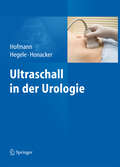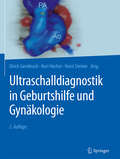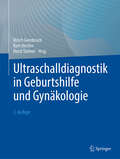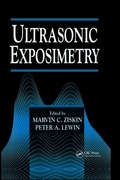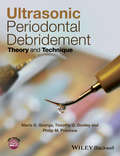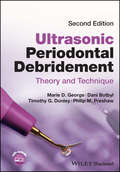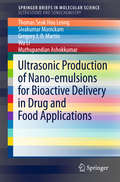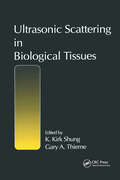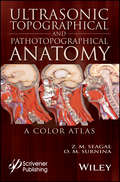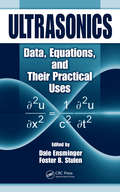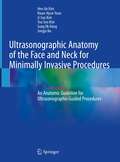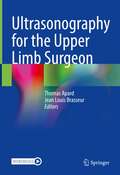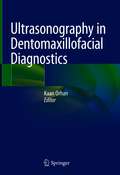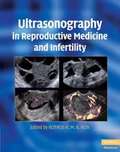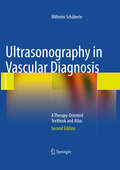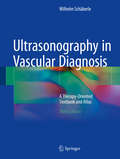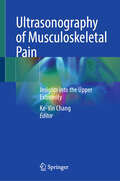- Table View
- List View
Ultraschall in der Urologie
by Rainer Hofmann A. Honacker Axel HegeleDer Ultraschall zählt zu den zentralen Untersuchungstechniken in der Urologie: Das Verfahren ist kostengünstig, verhältnismäßig schnell zu erlernen, praktisch überall einsetzbar und verursacht keine Strahlenbelastung. Der Atlas bietet einen reichen Fundus an Referenzaufnahmen höchster Qualität von häufigen, aber auch von seltenen Befunden. Die Autoren haben die Bilder mit knappen und präzisen Legenden versehen. Komplexe Befunde erläutern sie anhand anschaulicher Grafiken. Der Band eignet sich für Einsteiger wie für fortgeschrittene Diagnostiker.
Ultraschall in der Urologie
by Astrid StulaDer Ultraschall zählt zu den zentralen Untersuchungstechniken in der Urologie: Das Verfahren ist kostengünstig, verhältnismäßig schnell zu erlernen, praktisch überall einsetzbar und verursacht keine Strahlenbelastung. Der Atlas bietet einen reichen Fundus an Referenzaufnahmen höchster Qualität von häufigen, aber auch von seltenen Befunden. Die Autoren haben die Bilder mit knappen und präzisen Legenden versehen. Komplexe Befunde erläutern sie anhand anschaulicher Grafiken. Der Band eignet sich für Einsteiger wie für fortgeschrittene Diagnostiker.
Ultraschalldiagnostik in Geburtshilfe und Gynäkologie
by Ulrich Gembruch Kurt Hecher Horst SteinerDieses Buch führt den Leser praxisnah durch die ganze Bandbreite der geburtshilflichen und gynäkologischen Sonografie. Informieren Sie sich zu physiologischen Grundlagen, machen Sie sich mit den neuesten Ultraschalltechnologien vertraut, sehen Sie hilfreiche und exzellente Bilder zu allen Organsystemen, finden Sie Tipps und Tricks zu vermeidbaren Fehlern und vieles mehr. Alle Kapitel wurden für die 2. Auflage sorgfältig aktualisiert und sind auf dem neuesten Stand der klinischen Forschung. So erhalten Sie ein umfassendes Nachschlagewerk für den optimalen Einsatz der Sonografie.
Ultraschalldiagnostik in Geburtshilfe und Gynäkologie
by Ulrich Gembruch Kurt Hecher Horst SteinerDieses Standardwerk der pränatalen, geburtshilflichen und gynäkologischen Sonographie ist äußerst hilfreich für die Weiterbildung und Fortbildung in der Geburtshilfe und Gynäkologie. Sie erfahren alles über die Abläufe sonographischer Untersuchungen und den dabei nutzbaren Techniken, wie B-mode, Doppler- und Farbdoppler, 3D- und 4D-Volumensonographie, M-mode, Speckle Tracking, Gewebedoppler und Kontrastmittelsonographie sowie über ihren jeweiligen Einsatz bei der Diagnostik fetaler Erkrankungen und Anomalien und in Geburtshilfe, Gynäkologie und Reproduktionsmedizin.Herausgeber und Autoren teilen mit diesem Werk ihre jahrzehntelange Erfahrung und publizieren ein sehr umfangreiches Nachschlagewerk für das optimale klinische Vorgehen in üblichen wie schwierigen Situationen mit über 1500 exzellenten Bildern. Die 3. Auflage erscheint komplett auf den neuesten Stand der klinischen Forschung aktualisiert und mit neuen Themen, wie der Einsatz von künstlicher Intelligenz unddie intrauterine Chirurgie
Ultrashort Electric Pulse Effects in Biology and Medicine (Series in BioEngineering)
by Stephen J. Beebe Ravi Joshi Karl H. Schoenbach Shu XiaoThis book presents an overview of the current state of research on ultrashort electric field pulses of high intensity and their use in biology and medicine. It examines in detail the most recent and exciting advances in how nanosecond and picosecond electric pulse research has grown and expanded into new areas of biology and medicine. Further, the book specifically focuses on electric pulses in the time domain, on intracellular effects as opposed to plasma membrane electroporation, and highlights the biological and medical applications of these unique pulse effects. Since the authors were initial innovators exploring nanosecond and picosecond pulses, their unique perspectives foreshadowed directions the research took, expanding into new areas that they continue to investigate today.
Ultrashort Pulse Lasers and Ultrafast Phenomena
by Takayoshi KobayashiThis book describes the basic physical principles of techniques to generate and ultrashort pulse lasers and applications to ultrafast spectroscopy of various materials covering chemical molecular compounds, solid-state materials, exotic novel materials including topological materials, biological molecules and bio- and synthetic polymers. It introduces non-linear optics which provides the basics of generation and measurement of pulses and application examples of ultrafast spectroscopy to solid state physics. Also it provide not only material properties but also material processing procedures. The book describes also details of the world shortest visible laser and DUV lasers developed by the author’s group. It is composed of the following 12 Sections: The special features of this book is that it is written by a single author with a few collaborators in a systematic way. Hence it provides a comprehensive and systematic description of the research field of ultrashort pulse lasers and ultrafast spectroscopy. Generation of ultrashort pulses in deep ultraviolet to near infrared Generation of ultrashort pulses in terahertz Carrier envelope phase (CEP) Simple NLO processes with a few colors Multi-color involved NLO processes Multi-color ultrashort pulse generation NLO materials NLO processes in time-resolved spectroscopy Low dimension materials Conductors and superconductors Chemical reactions and material processing Photobiological reactions
Ultrasonic Exposimetry
by Marvin C. Ziskin Peter A. LewinUltrasonic Exposimetry presents the fundamentals of ultrasonics and discusses the theoretical background of acoustic wave generation and reception. Measurements, instrumentation, and interpretation of measured data (including error analysis) are examined in detail.
Ultrasonic Guided Waves in Solid Media
by Joseph L. RoseUltrasonic guided waves in solid media have become a critically important subject in nondestructive testing and structural health monitoring, as new faster, more sensitive, and more economical ways of looking at materials and structures have become possible. This book will lead to fresh creative ideas for use in new inspection procedures. Although the mathematics is sometimes sophisticated, the book can also be read by managers without detailed understanding of the concepts as it can be read from a 'black box' point of view. Overall, the material presented on wave mechanics - in particular, guided wave mechanics - establishes a framework for the creative data collection and signal processing needed to solve many problems using ultrasonic nondestructive evaluation and structural health monitoring. The book can be used as a reference in ultrasonic nondestructive evaluation by professionals and as a textbook for seniors and graduate students. This work extends the coverage of Rose's earlier book Ultrasonic Waves in Solid Media.
Ultrasonic Periodontal Debridement
by Timothy G. Donley Philip M. Preshaw Marie D. Georgemedical and dental considerations, and provides specific guidance in clinical debridement techniques. Included are technique modules for each quadrant as well as case studies using real-world examples of situations likely to be encountered in everyday clinical practice, including ultrasonic instrumentation around dental implants.
Ultrasonic Periodontal Debridement: Theory and Technique
by Timothy G. Donley Philip M. Preshaw Marie D. George Dani BotbylUltrasonic Periodontal Debridement A practical and comprehensive reference to all aspects of ultrasonic debridement in periodontal therapy, now fully updated and revised Ultrasonic Periodontal Debridement, Second Edition presents both theory and practice of ultrasonic debridement, including all the information needed to understand this clinical process and apply the knowledge to clinical practice. The Second Edition includes three entirely new chapters and expanded sections in all existing chapters, as well as updating the content and references throughout. The revision greatly expands the number of illustrations and incorporates the most recent advances in periodontal debridement therapy. The book begins with an introduction to the history and principles of ultrasonic technology and technique, then discusses practical guidance for using safe, effective, and efficient ultrasonic periodontal debridement in clinical practice. It is vividly illustrated, with hundreds of images, and emphasizes detailed, step-by-step descriptions. Ultrasonic Periodontal Debridement: Provides a common-sense, easy-to-read approach to topics ranging from pathophysiology to??clinical tips and tricks Features updates to reflect changes to practice and theory, with new chapters discussing??ultrasonic instrumentation for implant maintenance, aerosol transmission, and??aerosol management Presents hundreds of images to accompany the step-by-step descriptions, including images of left- and right-handed clinician-patient positioning specific to the use of ultrasonic instruments Supports dental students, dental hygiene and dental therapy students, practicing dentists, dental hygienists, and dental therapists in understanding and applying concepts related to ultrasonic debridement Ultrasonic Periodontal Debridement is a useful reference for students in dentistry, dental hygiene, and dental therapy, as well as for practicing dentists and dental hygienists and therapists.
Ultrasonic Production of Nano-emulsions for Bioactive Delivery in Drug and Food Applications (Springerbriefs In Molecular Science: Chemistry of Foods)
by Muthupandian Ashokkumar Sivakumar Manickam Wu Li Thomas Seak Leong Gregory J. MartinThis SpringerBrief provides an overview of ultrasonic emulsification and an update on recent advances in developing stable emulsions for the creation of novel drugs and functional foods, with a focus on bioactive delivery in these products.Emulsification is the process of combining two or more immiscible liquids to form a semi-stable mixture. These two liquids generally consist of an organic (oil) phase and an aqueous (water) phase that is stabilized by the addition of an emulsifier. Most common emulsions are of the oil-in-water (O/W) type, but can also be of water-in-oil (W/O) or even multiple emulsion types (i.e. double emulsions) in the form of water-in-oil-in-water (W/O/W) or oil-in-water-in-oil (O/W/O) phases. The formation of an emulsion requires input of energy to distribute the disperse phase in the continuous phase in small-sized droplets that are able to resist instability. There is great interest in the use of ultrasound to produce emulsions, as it is able to do so relatively efficiently and effectively compared to existing techniques such as rotor stator, high-pressure homogenization and microfluidization. The interaction of ultrasound with the hydrocolloids and biopolymers that are often used to stabilize emulsions can offer advantages such as improved stability or greater control of formed droplet size distributions.
Ultrasonic Scattering in Biological Tissues
by K. Kirk Shung Gary A. ThiemeUltrasonic Scattering in Biological Tissues contains 14 chapters written by world-renowned authorities who describe current work related to theoretical and experimental aspects of ultrasonic scattering phenomenon in biological tissues. Introductory material regarding ultrasonic scattering in biological tissues is presented, followed by discussions on theoretical treatments, experimental approaches, in vitro results on selective tissues, in vivo results on various tissues, and the current status of quantitative backscatter imaging. Ultrasonic Scattering in Biological Tissues will be an excellent reference for biomedical engineers, ultrasound specialists, biophysicists, and radiology researchers.
Ultrasonic Topographical and Pathotopographical Anatomy: A Color Atlas
by O. V. Surnina Z. M. SeagalWritten by experienced and well-respected physicians and professors, this new all-color volume presents the ultrasonic topographical and pathotopographical anatomy of the body, including the head, neck, chest, anterolateral abdominal wall, abdominal organs, retroperitoneal space, male and female pelvises, and lower extremities. Specific and non-specific ultrasonic symptoms are suggested for normal and abnormal developmental variants, diffuse and local pathotopographical anatomy. This color atlas contains comparative topographical and pathotopographical data and is the first manual of its kind for students and medical specialists in different areas, including those specializing in medical sonography. The original technology was tested at clinics in patients subjected to ultrasonic monitoring. Because of early detection there were no false-positive or false-negative results. The therapy was effective, and, in some cases, the use of the original method of "seagalography" (optometry and pulsemotorgraphy) has made it possible to develop new methods of treatment and/or to determine the optimal doses of drugs, as well as to develop effective drug complexes for treatment of a given pathology. This important new volume will be valuable to physicians, junior physicians, medical residents, lecturers in medicine, and medical students alike, either as a textbook or as a reference. It is a must-have for any physician's library.
Ultrasonic and Electromagnetic NDE for Structure and Material Characterization: Engineering and Biomedical Applications
by Tribikram KunduMost books on nondestructive evaluation (NDE) focus either on the theoretical background or on advanced applications. Bridging the gap between the two, Ultrasonic and Electromagnetic NDE for Structure and Material Characterization: Engineering and Biomedical Applications brings together the principles, equations, and applications of ultrasonic and
Ultrasonics: Data, Equations and Their Practical Uses
by Dale Ensminger Foster B. StulenGain a Unique and Comprehensive Understanding of UltrasonicsDespite its importance, most books on ultrasonics cover only very specific sub-fields of the science. They generally also take a more mathematical approach and lack the wider scope needed to truly improve understanding and facilitate practical use of ultrasonics across a wide range of disc
Ultrasonographic Anatomy of the Face and Neck for Minimally Invasive Procedures: An Anatomic Guideline for Ultrasonographic-Guided Procedures
by Hee-Jin Kim Kwan-Hyun Youn Ji-Soo Kim You Soo Kim Sung Ok Hong Jongju NaThis is the very first book to describe the superficial anatomic structure of the face and neck by means of detailed ultrasonography (US). This superbly illustrated book will help aesthetic physicians to familiarize themselves with the US anatomy of the face and neck and to understand the applications and benefits of US when performing minimally invasive aesthetic procedures in this region. A deep understanding of anatomy is imperative if such procedures are to be safe and effective. Bearing in mind the range of potential anatomic variations, US can offer vital assistance in identifying target structures of the face beneath the skin when carrying out treatments that would otherwise be performed “blind”. In this book, readers will find detailed guidance on the use of US in the context of botulinum toxin and filler injections, threading procedures, and other minimally invasive aesthetic approaches. This is done with the aid of more than 530 US images, including cadaveric dissections and illustrations of volunteers and patients. For novices, valuable information is also provided on the basics of US imaging.
Ultrasonography Diagnosis of Peripheral Nerves: Cases and Illustrations
by Dingzhang Chen Minjuan ZhengAs a hot topic in ultrasound medicine, peripheral nerve ultrasound has its wide applications in clinical field. This book firstly introduces the anatomy of peripheral nerves, method and normal sonograms for peripheral nerve scanning. In the following chapters, common and typical cases of peripheral nerves diseases are presented with useful clinical information and relevant data, for example, ultrasound, MRI, clinical operation and pathology results. At the end of each disease, video with detailed explanation of diagnostic procedure and 2-3 bullet points in practical differential diagnosis are included to help readers taking notes. This book will be a valuable reference for physicians in ultrasound, anesthetists, neurologists, pain specialists, and practitioners interested in related field.
Ultrasonography for the Upper Limb Surgeon
by Thomas Apard Jean Louis BrasseurThis book combines orthopedists’ and radiologists’ perspectives to provide a comprehensive overview of the rapidly expanding use of ultrasound in orthopedic surgery. It also highlights the growing awareness of the potential of this non-invasive and portable, real-time imaging tool, which has led to its inclusion in the minimally invasive toolkit of upper limb surgeons.The book is divided into five parts – shoulder, elbow, forearm, hand and wrist and fingers. Each part focuses on a particular anatomic region or joint, carefully analyzing the sonoanatomy of its nerves, tendons and bones. For each region, experienced experts illustrate how to perform specific techniques under ultrasound control, ranging from classic procedures, like carpal tunnel release, to the treatment of less common conditions. Covering all the basic and practical aspects of this innovative, multi-disciplinary approach, as well as future perspectives, this unique book is a must-read for all orthopedists, radiologists, sports physicians and physiotherapist wanting to gain insights into this promising field.
Ultrasonography in Dentomaxillofacial Diagnostics
by Kaan OrhanThis book offers a comprehensive review of the state of the art in Ultrasonography (USG) dentomaxillofacial imaging to help radiologists and dentists in their training and daily practice.The book examines the relationship between clinical features, diagnosis, and choice of minimally invasive technique for a range of dentomaxillofacial disorders and provides information on post-treatment therapy. Accurate interpretation of indications for treatment is the cornerstone of success in medicine, and as such, the book explains how the selection of imaging technique is closely linked to clinical and diagnostic aspects and how recognition of this relationship forms the foundation for optimal outcomes. In addition to examining the various modalities, the book highlights the role of the latest USG imaging techniques. Further, it discusses in detail the pathology, treatment, and prognosis of common and rare diseases, as well as congenital/developmental malformations in the dentomaxillofacial, an area that is often underestimated and largely ignored by dentists.Featuring updated high-resolution images created with state-of-the-art equipment, the book introduces readers to current imaging modalities. It also includes pathological descriptions of radiologic diagnoses to help clarify the pathophysiology of the disease, while the pearls and pitfalls of image interpretation provide a quick reference guide for practitioners.Written by leading international experts, this outstanding book is a valuable resource for both radiologists, dentists and students seeking a more in-depth appreciation of the subject and its contribution to the scientific radiology community.
Ultrasonography in Gynecology
by FACS Botros R. M. B. Rizk Frcog Facog Hcld Frcs C Elizabeth E. PuscheckUltrasonography is a cornerstone in the evaluation of gynecologic disease. This authoritative new book looks at the techniques of ultrasonography in both office and hospital settings, offering guidance on the optimal use of equipment and covering the full range of benign and malignant gynecologic disease as well as infertility. Ultrasonography in Gynecology offers extensive coverage of the diagnostic potential of ultrasound in gynecologic disease, from the moment the patient walks into the physician's office. All the different approaches in the ultrasonographic evaluation of disease – including 3D ultrasonography, 3D sonohysterography, Doppler imaging and pelvic floor imaging – are extensively covered, with color images throughout. Written and edited by leaders in the field of ultrasonography who have actively participated in national and international teaching courses, Ultrasonography in Gynecology is a must for all gynecologists dealing with infertility, endometriosis, uterine fibroids, gynecologic cancers, and many more gynecologic conditions.
Ultrasonography in Reproductive Medicine and Infertility
by Botros R. M. B. RizkNowhere has the impact of ultrasonography been more dramatic than in reproductive medicine, particularly in the diagnosis of female and male infertility, the management of assisted reproductive procedures and the monitoring of early pregnancy. This authoritative textbook encompasses the complete role of ultrasonography in the evaluation of infertility and assisted reproduction. Covering every indication for ultrasonography in assisted reproductive technology, this will prove an invaluable resource in the evaluation of the infertile patient and optimization of the outcome of treatment. The interpretation of images to improve fertility and reproductive success is emphasized throughout. Ultrasonography in Reproductive Medicine and Infertility is essential reading for clinicians working both in IVF clinics and in office practice. It will be particularly useful to gynecologists, infertility specialists, ultrasonographers and radiologists working in reproductive endocrinology and infertility, assisted reproductive technology, ultrasonography and radiology.
Ultrasonography in Vascular Diagnosis
by Wilhelm Schäberle B. HerwigThis is the second edition of a well-received book that has been recommended for inclusion in any vascular library or vascular radiology suite. The first edition has been fully revised so as to provide a comprehensive, up-to-date account of vascular ultrasound that reflects recent advances. The emphasis remains on the clinical aspects most relevant to angiologists and vascular surgeons. Ultrasound anatomy is discussed, examination procedures explained, normal and pathological findings described, and the clinical impact of ultrasound assessed. Atlas sections present pertinent case material to illustrate typical ultrasound findings for both the more common vascular diseases and rarer conditions. This book will serve not only as an invaluable guide for beginners, but also as an indispensable reference for experienced sonographers, who will benefit from the detailed evaluation of the role of ultrasound as compared with other modalities and the discussion of ultrasound findings in their clinical context.
Ultrasonography in Vascular Diagnosis: A Therapy-oriented Textbook And Atlas
by Wilhelm Schäberle Bettina HerwigDer Band fasst die modernen Verfahren und neuesten Erkenntnisse auf dem Gebiet der Gefäßdiagnostik zusammen. Der Textteil beschreibt die Gefäßregion mit Sonoanatomie, Untersuchungsablauf und Normalbefund sowie die Indikation der Ultraschalluntersuchung und die klinische Relevanz der Untersuchungsergebnisse. Der Atlasteil veranschaulicht anhand aussagekräftiger Ultraschallbilder die verschiedenen Krankheitsbilder. Die 3. Auflage behandelt verstärkt die Bedeutung der Ultraschall-Routinediagnostik für seltene Gefäßerkrankungen.
Ultrasonography in the ICU
by Paula FerradaThis text presents a basic guide of the principles and applications of ultrasound in the critical care setting. The text also addresses the basic and clinical uses of ultrasound, including clinical cases at the end of each of the 7 sections of the clinical subdivisions. The final chapters focus on the issues of training, certification, credentialing and billing. These discussions make the text unique, as literature regarding monetary and training issues for ultrasound in the ICU is sparse. Each chapter is written by experts in the field, and supplemented with illustrations and links to videos of actual ultrasound examinations in patients. Ultrasonography in the ICU: Practical Applications will be of great utility to critical care specialists in the disciplines of surgery, medicine, anesthesiology and emergency medicine. In addition this book can be used as a teaching tool for critical care fellows and residents interested in further training in ultrasound for the critically ill patient.
Ultrasonography of Musculoskeletal Pain: Insights into the Upper Extremity
by Ke-Vin ChangThis book is an essential resource for medical practitioners who use ultrasound technology to diagnose and manage musculoskeletal pain, with a particular focus on clinical syndromes of the upper extremity. Moving beyond the traditional emphasis on normal sonoanatomy, it introduces diagnostic criteria for musculoskeletal disorders from various ultrasound perspectives, offering a comprehensive approach to both assessment and intervention. The chapters cover a wide range of conditions, including adhesive capsulitis, subcoracoid pain, and the complexities of the axillary region. Readers will gain insights into lateral and medial elbow pain, De Quervain&’s disease, and carpal tunnel syndrome. The authors, experienced clinicians in the field, provide detailed guidance on ultrasound-guided injection techniques, equipping practitioners with practical skills for pain management. This book stands out for its strong clinical perspective, enhancing musculoskeletal anatomy knowledge and offering structured protocols for diagnosis and treatment. Designed for physicians across multiple specialties—including physical medicine and rehabilitation, sports medicine, orthopedics, rheumatology, and primary care—this book serves as a comprehensive reference for those seeking to expand their expertise in ultrasound applications for musculoskeletal conditions. It is also a valuable addition to medical institutions and training programs focused on musculoskeletal health. By delivering a thorough exploration of ultrasound-guided techniques, this volume empowers practitioners to enhance patient care and optimize treatment strategies for musculoskeletal pain.
